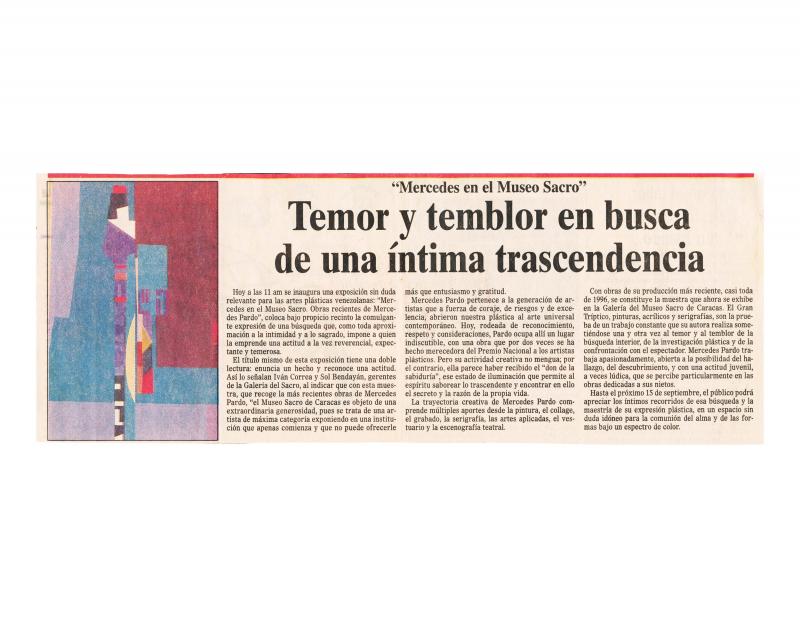The title of the article, “El azul y el mas allá” (The Blue and Beyond), refers to the author’s comments on the symbolic meanings of color in the text, where blue is associated with “celestial boundaries.” Journalist Gustavo Jaén is in fact introducing the Venezuelan public to the most recent exhibition titled Mercedes en el Museo Sacro. Obras Recientes de Mercedes Pardo (Caracas, August 11–September 15, 1996). Jaén refers to the colonial architecture and the recent restoration of the museum spaces; it was founded in 1888 as an Episcopal School, and underwent significant restoration after it was declared a National Historical Monument (1981). The building stands on the site of the ancient cemetery of the Caracas Cathedral (1673–1872). Due to the significance of the location in the national history of Catholicism, the museum is managed by the Archdiocese of Caracas and its collections and exhibitions were dedicated to religious art. This explains Jaén’s approach to Mercedes Pardo’s (1921–2005) abstraction from her view of color, in search of what can be seen as “sacred” in her production. The anecdote of the political figure Arturo Uslar Pietri (1906–2001), in which he refers to an exhibition space with Pardo’s work as “a cathedral,” helps the author support his argument linking religion and Pardo’s production. It refers to Pardo’s retrospective Moradas del Color, held in 1991 at the GAN.
A large part of the article is dedicated to Pardo’s family. Her four grandchildren are mentioned: Diana, Inés, Camila, and Diego; among the twenty-four works in the exhibition, four were made for them: Viva Diana, Astrolabio de Simbad, King Arthur’s Unpredictable Ghost, and La Locomotora de Diego. Other articles that review this exhibition also center their accounts on this familiar bond. The relationship with Pardo’s husband, Alejandro Otero’s (1921–1990), is also mentioned, and Jaén highlights their mutual respect for their creative differences.
[For other articles on the Museo Sacro exhibition of Pardo’s work, see in the ICAA Digital Archive: Virginia Minaya, “Soy pintora existencial y de pocas galerías” (doc. no. 1331020); Yasmin Monsalve, “Vivo la pintura siempre, ese es mi modo de ser” (doc. no. 1331036); and Anonymous, “Temor y temblor en busca de una íntima trascendencia” (doc. no. 1331053). For readings that highlight Pardo’s experimental approach, see Gloria Carnevali, “El Espacio en la pintura de Mercedes Pardo” (doc. no. 1102285); and María Fernanda Palacios, “Pintura y vida” (doc. no. 1102253).]





